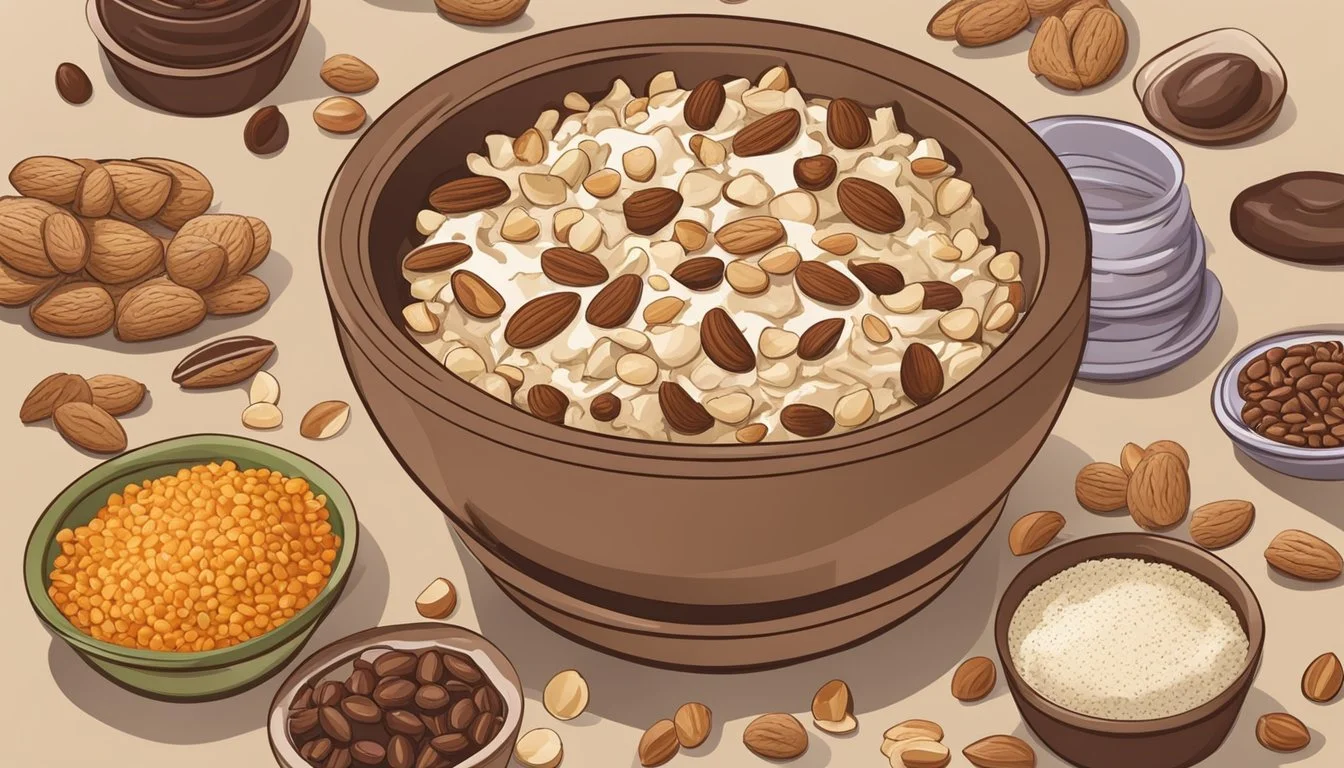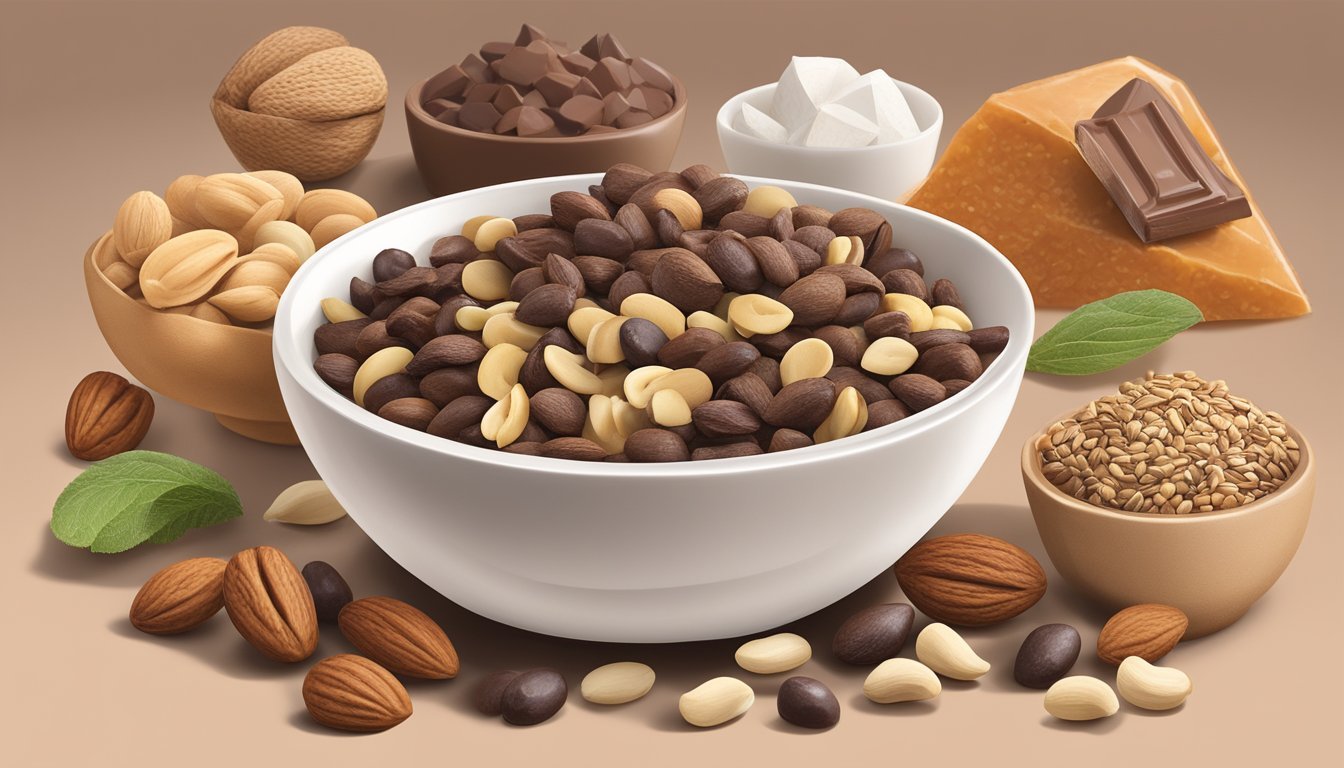Chocolate Chip Substitutes
Top Alternatives for Baking
In the realm of baking and cooking, chocolate (What wine goes well with chocolate?) chips have become a staple for many. Their sweet, melty quality adds a touch of decadence to an array of recipes from cookies and muffins to pancakes and granola bars. However, there are times when one either needs an alternative due to dietary restrictions, health considerations, or simply because the pantry is lacking this key ingredient. It's in these moments that chocolate chip substitutes come into play, offering a seamless transition in texture and flavor to the final product without compromising on taste.
Substitutes for chocolate chips are varied and can cater to different needs, whether one is looking for a less sugary option or a non-dairy replacement. Nuts such as almonds or cashews provide a crunchy texture and a hint of savory flavor, making them a suitable choice for those cutting back on sugar. Meanwhile, yogurt chips offer a creamy consistency with a tangy twist that can enhance baked goods. For a butterscotch flavor, butterscotch chips serve as a straightforward swap for chocolate chips, capturing a similar texture with a different taste profile.
The key to successful substitution lies in understanding the original role that chocolate chips play in a recipe and finding an alternative that maintains the balance of flavor and texture while aligning with the specific requirements of the dish. Substitutes are not just a last resort; they are an opportunity to experiment and personalize recipes, potentially discovering new favorite combinations along the way.
Understanding Chocolate Chips
Chocolate chips are a staple ingredient in many baked goods, offering a distinct flavor and melting properties that make them ideal for recipes like cookies and muffins.
Chocolate Chip Properties
Chocolate chips are small chunks of chocolate that are available in various types, each with distinct characteristics. The three primary types are semi-sweet, milk chocolate, and dark chocolate.
Semi-sweet Chocolate Chips: They have a balanced sweetness and contain a moderate amount of sugar. They are versatile and commonly used in baking.
Milk Chocolate Chips: These chips are sweeter and creamier than semi-sweet, incorporating milk solids in their composition.
Dark Chocolate Chips: With a higher percentage of cocoa, they have a deeper flavor and less sweetness, making them suitable for those who prefer a less sugary option.
Chocolate chips can also come from a chopped chocolate bar, ensuring that the flavor and melting characteristics are identical to the original product.
Role in Baking
In baking, chocolate chips not only add flavor but also impact the texture and appearance of the final product.
Flavor: Chocolate chips introduce a concentrated burst of chocolate flavor into a bite. The type of chip can profoundly affect the sweetness and chocolate intensity of a recipe.
Texture and Distribution: They maintain their shape under moderate heat, providing a soft yet distinct textural element. Their small size allows for even distribution throughout a dough or batter.
For cookies, chocolate chips are essential, melting slightly during the baking process, which leads to gooey or soft textured spots within the cookie. Their role is not just additive for flavor but also for creating an appealing contrast with the cookie dough.
Reasons for Substitution
When a recipe calls for chocolate chips, various considerations might lead a baker to seek alternatives. The primary reasons relate to health, dietary choices, personal taste, and the convenience of obtaining certain ingredients.
Dietary Restrictions
For individuals who follow specific diets, such as vegan or low-sugar diets, traditional chocolate chips may not be suitable. Vegans will avoid chocolate chips containing dairy, opting for dark or dairy-free options. Those managing their sugar intake might prefer sweeteners like Stevia-based chips or unsweetened cocoa powder.
Allergies and Sensitivities
Food allergies can make common ingredients like chocolate chips off-limits. Chocolate often contains allergens such as milk or soy lecithin. Safe substitutes for those with allergies might include carob chips or allergen-free chocolate-flavored morsels, which do not contain common allergenic ingredients.
Texture and Taste Preferences
Bakers may swap chocolate chips for ingredients that alter texture or flavor profiles. White chocolate or butterscotch chips provide a creamier and sweeter taste, while nuts such as almonds or cashews offer a crunchy texture and a savory touch. Ingredients like coconut flakes or dried fruit can also introduce new textures and flavors to a dish.
Availability and Accessibility
Sometimes, the choice to substitute stems from the availability of chocolate chips in one's pantry or local stores. In such cases, finding a replacement becomes necessary. Cocoa powder mixed with a fat like butter and sweetener can mimic the chocolatey flavor, and items like peanut butter chips or yogurt chips might be more readily available in some areas.
Substituting Chocolate Chips in Sweet Treats
In the quest for the perfect sweet treat, one might need to swap out chocolate chips for various reasons, be it dietary restrictions, flavor profiles, or simply running out of them. Each substitute brings its own qualities to baked goods, from texture to sweetness levels.
Using Chocolate Bars and Baking Chocolate
When chocolate chips are not available, chocolate bars and baking chocolate can be employed effectively. One can chop chocolate bars into smaller chunks to mimic the size and texture of chips. Baking chocolate, which comes in both sweetened and unsweetened varieties, can also be cut into chunks, although one should adjust the recipe's sugar content if using unsweetened chocolate to maintain the desired sweetness.
Cocoa Powder and Carob Alternatives
For a more intense chocolate flavor without the texture of chips, cocoa powder is a suitable substitute. Substitute one ounce of chocolate chips with a combination of:
3 tablespoons of cocoa powder
1 ½ teaspoons of butter, oil, or shortening
1 to 1 ½ tablespoons of sugar
This mixture will not provide the same mouthfeel as chocolate chips but will impart a rich chocolate flavor to the dish. For those seeking a caffeine-free option, carob chips offer a similar sweetness and can be used in a one-to-one ratio in place of chocolate chips.
Sweet Chocolate Substitutes
Besides chocolate bars and baking chocolate, there are other sweet substitutes that can be used. White chocolate chunks offer a creamy taste and a different color palette for visual interest. One can also consider peanut butter chips or butterscotch chips for a different flavor profile while still maintaining the familiar chip texture in the final product.
Substituting Chocolate Chips in Cookies
When baking cookies, there are numerous substitutes that can replace chocolate chips to cater to different tastes and dietary requirements. One can select from a variety of nut- and fruit-based options or explore innovative ingredient swaps to enhance the flavor and texture of cookies.
Nut- and Fruit-Based Substitutes
Nuts provide richness and a satisfying crunch to cookies, acting as an excellent chocolate chip alternative. Common choices are:
Chopped walnuts – They offer an earthy, nutty flavor.
Macadamia nuts – Known for their buttery taste, these can be chopped and used in recipes.
Almonds – Slivered or chopped, they add a delicate crunch.
Fruit-based substitutes like raisins add natural sweetness and a chewy texture, making them another healthy option. They are particularly versatile and complement a range of flavors in cookie recipes.
Innovative Ingredient Swaps
Apart from nuts and fruits, there are other creative substitutions that can mimic the role of chocolate chips in cookies:
Peanut butter chips – They infuse a creamy, nutty essence into cookies.
Yogurt chips – These are a tangy, creamy alternative often used for their distinctive taste and texture.
Exploring different ingredients opens up a new realm of flavors and experiences in the kitchen, allowing bakers to customize their cookie recipes to personal preferences or dietary restrictions.
Substituting Chocolate Chips in Other Baked Goods
When altering recipes in baking, substituting chocolate chips requires careful consideration of the flavor and texture profile of the baked goods. The chosen substitute should complement the existing ingredients and maintain a similar melting point to ensure consistency.
Pies and Tarts
For pies and tarts, bakers often seek alternatives that contribute to the richness of the filling without overpowering other flavors. Butterscotch chips serve as a suitable substitute, offering a creamy, buttery flavor with a hint of salt that can enhance the overall taste of the dessert. Another alternative for fruit-based pies or tarts is chopped nuts, like almonds or cashews, which introduce a textural contrast along with a subtle sweetness and savory note.
Butterscotch Chips Synergy: Complements caramelization in pies like apple or pecan.
Chopped Nuts Texture: Adds a crunchy counterpoint to soft fillings.
Cakes and Brownies
Cakes and brownies benefit from substitutes that mirror the mouthfeel of chocolate chips while providing a complementary taste. Yogurt chips might be an unconventional choice, yet they melt smoothly and impart a tanginess that can lighten the dense texture of brownies. When one is aiming for a less sweet profile, cocoa powder mixed with butter or oil can adjust the chocolate flavor intensity accordingly. Remember, to replace two ounces of chocolate chips, mix together:
3 tablespoons of cocoa powder
1 ½ teaspoons of butter or oil
1 to 1 ½ tablespoons of sugar
This blend should be thoroughly combined and used in a one-to-one ratio to the chocolate chips initially required. However, it will not provide the same texture as chocolate chips but will ensure a chocolatey flavor throughout the baked good.
Non-Chocolate Substitutes
Non-chocolate substitutes provide an array of flavors suitable for those looking to deviate from traditional chocolate chips. They offer distinctive taste profiles that can enhance various baked goods and confections.
Yogurt and Butterscotch Options
Yogurt chips are a creamy and tangy alternative to chocolate chips, ideal for those seeking a subtle sweetness in their baked goods. Their texture is smooth, and they can commonly be used in a one-to-one ratio with chocolate chips. Here's a brief comparison:
Yogurt Chips: Yogurt-flavored, creamy, and ideal for health-conscious recipes.
Butterscotch Chips: Rich, sweet with a buttery flavor, merging seamlessly in recipes calling for a caramel-like taste.
Using Nut Butters and Caramel
Nut butter chips introduce a nutty flavor to recipes, with the addition of a rich, creamy texture. They're often used in conjunction with other ingredients to balance out sweetness and add depth. Nut butter chips can be made from various nuts, including peanuts, almonds, and cashews.
Caramel Chips: Offer a sweet, burnt sugar taste and are perfect for adding a chewy texture.
Caramel, alternatively, can be incorporated as a ribbon or swirl in the batter or dough, providing a smooth, molten contrast to the surrounding crumb. It can also be drizzled atop finished baked goods for an enticing presentation.
Caramel Drizzle: An aesthetic and flavor boost, often used for finishing touches.
Nutritional Considerations
When considering substitutes for chocolate chips in recipes, it is critical to examine their nutritional content, particularly focusing on fat, sweeteners, and essential nutrients. The substitutes' impact on the overall health profile of the recipe can determine their suitability for various dietary needs.
Comparing Fat Content
Substitutes for chocolate chips vary widely in their fat content. For example, sunflower seeds provide healthy fats and a satisfying crunch while also offering a decent amount of protein. On the other hand, yogurt chips may contain added fats from dairy, and their creamy texture often comes with a higher saturated fat content. Nuts such as almonds or cashews can be rich in monounsaturated fats, which are beneficial for heart health.
Substitute Type of Fat Notable Effects Sunflower Seeds Unsaturated fats Good for heart and skin health Yogurt Chips Saturated fats Should be consumed in moderation Nuts Monounsaturated fats Promote heart health
Understanding Sweeteners and Additives
Sweeteners and additives in chocolate chip substitutes can significantly affect the sugar content of a recipe. Products like butterscotch chips often have high levels of sugar and additives that contribute to the overall sweetness and flavor profile. Cocoa powder, when used as a substitute, must be balanced with a sweetener such as sugar, and a fat like butter, to mimic the taste and texture of chocolate chips. When evaluating sweeteners, one must be cautious of the potential for excessive sugar consumption and the inclusion of artificial additives which could impact dietary restrictions.
Essential Vitamins and Minerals
Chocolate chip substitutes can offer a range of vitamins and minerals. Sunflower seeds are a nutrient-rich alternative, providing substantial amounts of vitamin E which aids in immune function and skin health. While nuts are a great source of antioxidants and minerals such as magnesium, that support various bodily functions. Yogurt chips, although less nutrient-rich than seeds or nuts, can still contribute some calcium to the diet. It’s important for consumers to weigh these nutritional benefits against potential drawbacks like added sugars when choosing a substitution that aligns with their health goals.
Technical Aspects of Substitution
When substituting chocolate chips in a recipe, precise measurement and consistency of the alternative ingredient are crucial to maintain the desired texture and flavor profile. Adjustments to baking time and temperature may also be necessary to ensure the best outcome.
Measurement and Consistency
Measurement: When replacing chocolate chips, it's vital to use the correct volume or weight to achieve the intended taste and texture. For example, if one is substituting chocolate chips with nuts, they should consider the size and density differences.
Chocolate Chips Yogurt Chips Carob Chips Cocoa Powder Mix 1 cup 1 cup 1 cup 1/4 cup
Consistency: Different substitutes, such as nuts or dried fruits, have different moisture content and fat, which can affect the final consistency of the baked good. Yogurt chips, which can be more creamy, may alter the moisture balance in the dough, while something like butterscotch chips might contribute a different melting point.
Impact on Baking Time and Temperature
Baking Time: Some ingredients may cause the recipe to bake more quickly or slowly. For instance, marshmallows can brown faster than chocolate chips, potentially requiring a shorter baking time.
Temperature: The melting point varies among substitutes. For example, carob chips burn at a lower temperature than chocolate chips, which might require adjusting the oven's heat to avoid scorched cookies.
When substituting chocolate chips, chefs should also keep in mind that the overall flavor profile will change depending upon the selected substitute and they should adjust their recipe as necessary.
Creative and Seasonal Substitutes
When incorporating chocolate chip substitutes, one can align their choices with the festivity of a season or a holiday. Seasonal ingredients can introduce a refreshing twist on flavor and add a celebratory note to any dish.
Holiday-Themed Ingredients
During holidays, flavors such as peppermint, ginger, and cinnamon take center stage. Bakers can replace chocolate chips with crushed peppermint candies for a winter holiday flavor. These impart a cool, minty taste that is particularly festive. For autumn, consider using pumpkin seeds or spiced nuts like cinnamon almonds, which can provide a warm, spicy note to baked goods.
Summer Refreshments
In the hotter months, one's palate often craves lighter, more refreshing flavors. Bakers might opt for lemon zest, dried berries, or yogurt chips to capture the essence of summer. Dried berries offer a tart sweetness, perfect for balancing against the richness of traditional baked goods, while yogurt chips introduce a tangy, creamy element that can lighten the dish's profile.
Substitute Flavor Note Usage Crushed Peppermint Cool, Minty Ideal for cookies and brownies Spiced Nuts Warm, Earthy with a spicy finish Suited for breads and muffins Lemon Zest Citrus, Refreshing Compliments cakes and scones Dried Berries Tart, Sweet Works well in cookies and bars Yogurt Chips Creamy, Tangy Suitable for muffins and cakes
By carefully selecting ingredients that resonate with the season or holiday, bakers can create desserts that not only taste delicious but also enhance the thematic experience for those who enjoy them.







